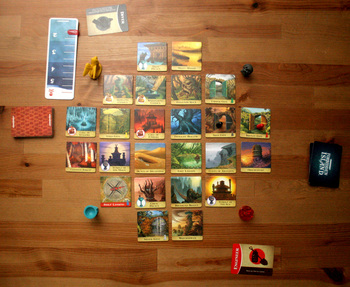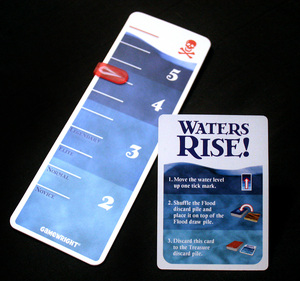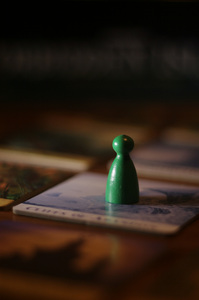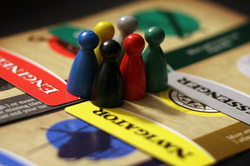Forbidden Island: A cooperative game for adults and families

Mike Hulsebus | Contributor
Last week we looked at Arkham Horror, a cooperative game that is great though time consuming and rules intensive. Today, as a contrast, we look at Matt Leacock’s Forbidden Island, which is a cooperative family game.
In Forbidden Island, up to four players play as adventurers on an island with four magic treasures on it. The island itself is magically trapped to sink into the ocean if anyone should try to take the treasures, so players have to work together to get the treasure and get airlifted off the island before the island sinks into the ocean taking them and the treasure with it.
Game designer Matt Leacock is best known for his cooperative game, Pandemic, a game about running around the world and containing diseases before the world is overrun and the players lose. If you have played Pandemic before, Forbidden Island will have some very familiar game mechanics, which is certainly not a bad thing.
The game starts by laying out 24 island tiles randomly to form an island that is different every game. The island then immediately starts to flood, six of those tiles being flipped to their “flooded” side. Players then arrive on the scene and start taking turns. Players have a few different actions they can accomplish on a turn: moving between tiles, shoring up (a.k.a. flipping flooded tiles back to normal), and giving cards to each other while in the same location.

The Waters Rise card, similar to Pandemic's Epidemic card, is the mechanic for making the game get increasingly difficult as time goes by.
Mike Hulsebus | Contributor
Then, each turn, cards are turned over that say which additional tiles get flooded. Players don’t face a penalty for letting tiles start to flood until the “Waters Rise!” card shows up. The Waters Rise card ups the rate at which tiles flood and resets the flood card deck by putting the already used flood cards on the top of the deck. If a card shows a tile that is already flooded, that tile sinks into the abyss and is removed from the game, leaving a gap in the island where it used to be that players must now work around.
It may seem a simple task at first to get all the treasures on the island, but it isn’t. While players collect sets of cards that will allow them to get the treasure, they must also balance making certain that the tiles that allowing them to turn in their cards for treasure do not sink into the abyss.
At the start of the game, players set the starting water level on the track that determines how many tiles get flooded per turn which also sets the difficulty. The rulebook suggests “If this is your first time playing a cooperative game, set it to the Novice [difficulty] level” so I figured that the first game for my wife and I would be a breeze. It was not.

Mike Hulsebus | Contributor
See, in order to capture a treasure, you need to collect four cards showing that treasure and travel to a tile where you can capture that treasure. But there are only five of each card in the treasure deck. The previously mentioned Waters Rise cards also are in the treasure deck, so the more times that players have to go through the treasure deck, the quicker the island is going to sink. Players can hold only five cards in their hand and so must work together to be as efficient with treasure cards as possible.
What I like most about Forbidden Island is that it’s easy to pick up for new players. The typical problem with the cooperative game experience is that usually more experienced players end up telling the new players what to do on their turn—after all, they want to win—and new players don’t really get to “play” until their second or third game.
Not so with Forbidden Island. The game is easy enough to explain that new players can make decisions for themselves without dragging the team down.
The game doesn’t market itself as a family game, but I listed it as such because I think this is a great family game. The box lists ages 10 and older but I think you could play it with slightly younger children, perhaps adjusting the difficulty accordingly to give players a handicap while still keeping the game fun.
For lovers of Pandemic, Forbidden Island is a great way to get some hooks into non-gamer friends to see if you can graduate them to Pandemic. Make no mistake though, Forbidden Island is a different game from Pandemic. It shares similarities, yes, but Pandemic is good for people willing to sit down for an hour and burn through a puzzle where Forbidden Island is a quick 30-minute strategy adventure.

There are six different roles for players, each that has its own special ability.
Mike Hulsebus | Contributor
Furthermore, the game is about $15. It has great components and great tiles as well as a lot of reply value, yet the publisher set the price at only $15. In a game industry where deck-of-card games can run as much as $30, it’s nice to see a game of good quality with good production values coming out for under half the price. You’ve spent $15 on far stupider things, so why not give cooperative gaming a go to see how you like it?
I’ve played four different games of Forbidden Island since the review copy that Gamewright sent arrived, and have had a lot of fun each time. Now, after this time I feel like we have finally “figured out” Novice difficulty and are ready to move on. I’m curious to see if the game remains to be exciting over time, but so far it’s been fun and we look to finally soon knock it up to the actual regular difficulty setting now that we’re starting to see the nuances of the strategy.
One final thing I wanted to note: When I was reading the rules I was worried that the island was going to flood too randomly, but I was pleasantly surprised to find that, since the edges of the island are hardest to get to, the island usually floods much like an island would. My wife and I had one game where we helicoptered off the island at the last second leaving behind only three tiles that the waters hadn't consumed.
If you’re interested in picking up the game yourself, rumor has it that they’re hoping to get the game into more mainstream stores (Target), but shipments are still on their way to stores so that’s yet to be seen. I was at Get Your Game On here recently and they said they plan to get their first shipment on Friday.
One Sentence Reviews
Jake: The game felt like it was decided before we started. The deck's contribution was a bigger factor than my own.
Karen: I like playing a game like this where you work together rather than spending the entire game trying to ruin the other person's plans.
As always, thanks for reading everyone and I’ll catch you next Monday. Those of you who use RSS readers, you may find it easier to subscribe using my RSS feed.
Mike Hulsebus is fine with games that sometimes end in revealing one last card to find out if players live or die. If you can introduce him to Erwin Schrödinger’s ghost, email him at mikehulsebus@gmail.com.

